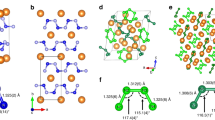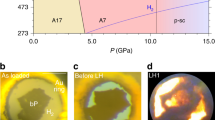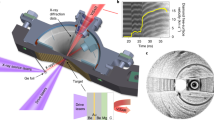Abstract
There has recently been much experimental and theoretical interest among astrophysicists in the synthesis of complex organic materials (polymers) as a consequence of the energy deposition by external agents on carbon-containing molecular solids such as CH4, C2H6, C3H8, C6H6 and mixtures with CO2, CO, NH3 and H2O. Solid residues have been obtained by bombardment of hydrocarbon rich frozen layers with UV photons1 and energetic particles2–4. We present here the first quantitative results on the rate of production of solid residues, obtained by bombarding thick (≍l019–1020C atoms cm−2) frozen layers (T≍4K) of methane with 1.5-MeV protons produced at the Catania University van de Graaff accelerator. This process converts the methane molecules to a polymer-like residue which is stable at room temperature and above. The thickness of the solid residues has been measured both in situ by elastic proton scattering (in C atoms cm−2) and remotely, by talysurf measurements (in μm). Thicknesses of up to 15 μm or 3.1 × 1019 C atoms cm−2 have been measured and the density of the residues is ρ ≥ 0.5 g cm−3. The process appears to occur along the entire path of the incoming protons.
This is a preview of subscription content, access via your institution
Access options
Subscribe to this journal
Receive 51 print issues and online access
$199.00 per year
only $3.90 per issue
Buy this article
- Purchase on Springer Link
- Instant access to full article PDF
Prices may be subject to local taxes which are calculated during checkout
Similar content being viewed by others
References
Greenberg, M. J. in Comets (ed. Wilkening, L. L.) 131–163 (University of Arizona Press, 1982).
Daube, M. E., Augustiniak, W. M., Brown, W. L., Lanzerotti, L. J. & Poate, J. M. EOS 59, 314 (1978).
Moore, M. H. & Donn, B. Astrophys. J. Lett. 257, L47–L50 (1982).
Strazzulla, G., Calcagno, L. & Foti, G. Mon. Not. R. astr. Soc. 204, 59p–62p (1983).
Mayer, J. M. & Rimini, E. (eds) Ion Beam Handbook for Material Analysis (Academic, New York, 1977).
Handbook of Chemistry and Physics 62nd edn (CRC Press, Boca Raton, 1981–82).
Johnson, R. E., Lanzerotti, L. J., Brown, W. L., Augustiniak, W. M. & Mussil, C. Astr. Astrophys. 123, 343–346 (1983).
Lanzerotti, L. J., Brown, W. L., Poate, J. M. & Augustiniak, W. M. Nature 272, 431–433 (1978).
Calcagno, L., Strazzulla, G., Fichera, M. & Foti, G. Rad. Eff. Lett. 76, 143–148 (1983).
Strazzulla, G., Cataliotti, R. S., Calcagno, L. & Foti, G. Astr. Aatrophys. (in the press).
Strazzulla, G. Icarus (in the press).
Mort, D. J. & Pfister, G. Electronic Properties of Polymers (Wiley, New York, 1982).
Apt, J., Carleton, N. P. & Mackay, C. D. Astrophys. J. 270, 342 (1983).
Author information
Authors and Affiliations
Rights and permissions
About this article
Cite this article
Foti, G., Calcagno, L., Sheng, K. et al. Micrometre-sized polymer layers synthesized by MeV ions impinging on frozen methane. Nature 310, 126–128 (1984). https://doi.org/10.1038/310126a0
Received:
Accepted:
Issue Date:
DOI: https://doi.org/10.1038/310126a0
This article is cited by
-
Ion Implantation and Chemical Cycles in the Icy Galilean Satellites
Earth, Moon, and Planets (2023)
-
Comets
The Astronomy and Astrophysics Review (1993)
Comments
By submitting a comment you agree to abide by our Terms and Community Guidelines. If you find something abusive or that does not comply with our terms or guidelines please flag it as inappropriate.



